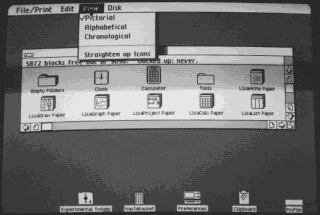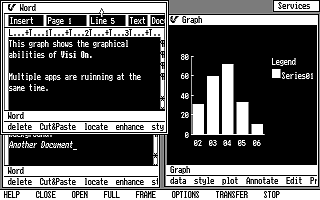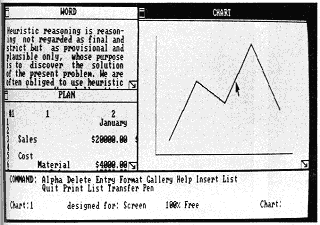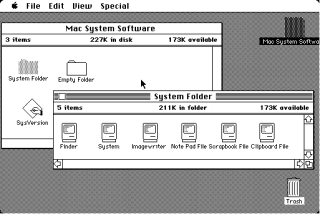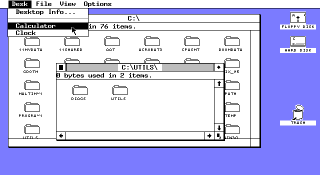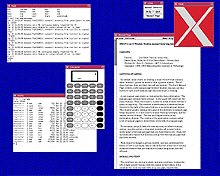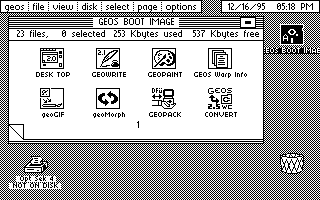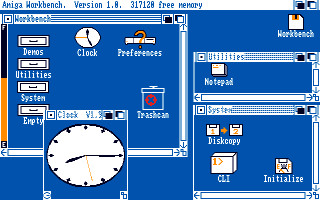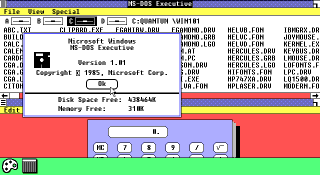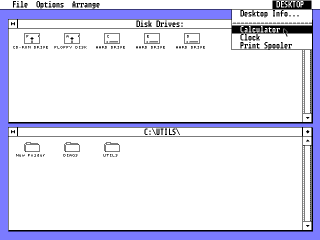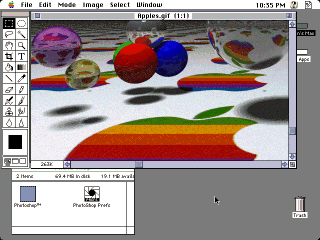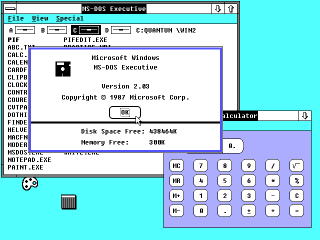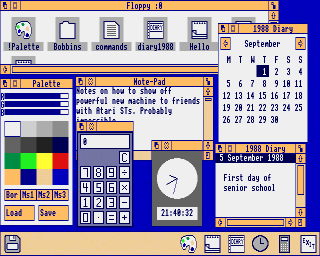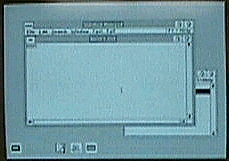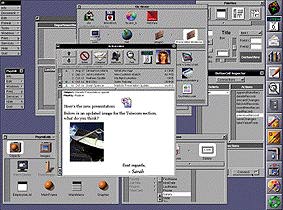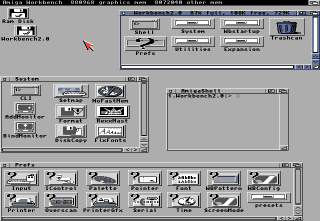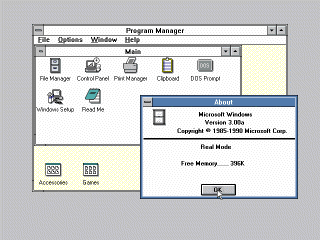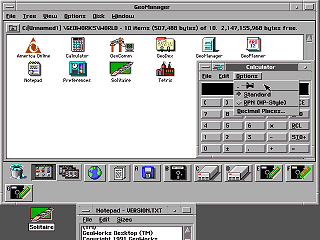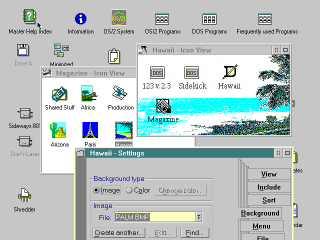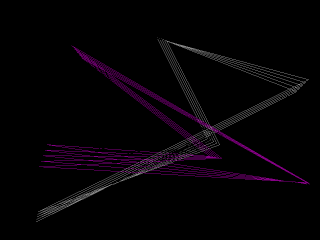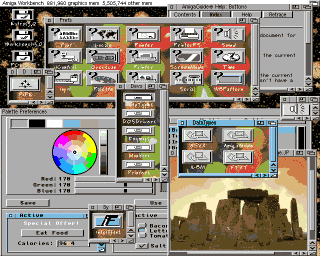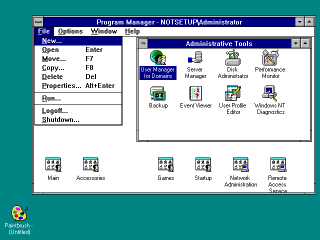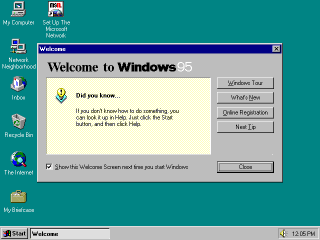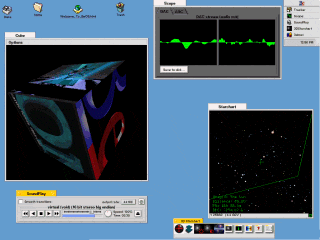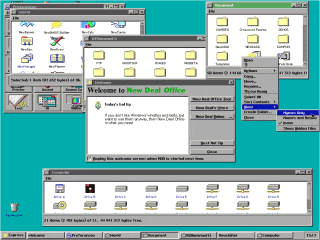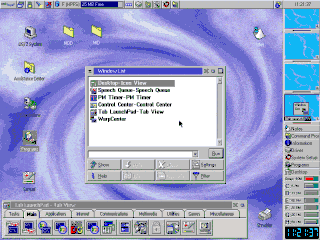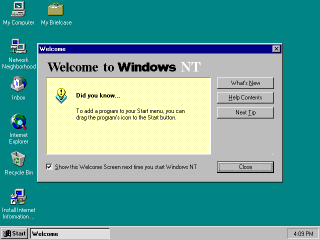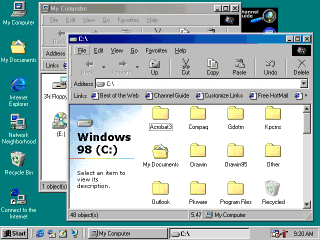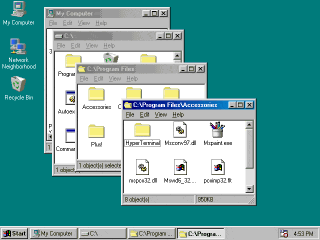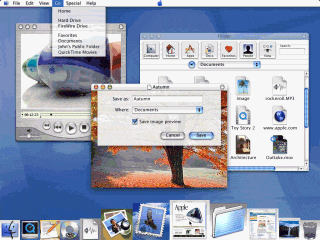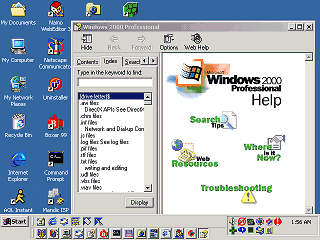图形用户界面(GUI)详细发展历史
2011-10-23 23:28
369 查看
图形用户界面(GUI)详细发展历史
2004-11-7 2:14:00来源:本站整理作者:蓝点559我要评论(0)History of the graphical user interface
The graphical user interface, or "GUI", is a computer interface that uses graphic icons and controls in addition to text. The userof the computer utilizes a
pointing device, like a mouse, to manipulate these icons and controls. This was a great leap forward from the
command line interface used in other operating systems, in which the user types a series of text commands to the computer.
Initial Developments
The first concept of a windowing system begins with the first real-time graphic display systems for computers, namely theSAGE Project and
Ivan Sutherland’s
Sketchpad.
Augmentation of Human Intellect
Doug Engelbart’s Augmentation of Human Intellect project atSRI in the
1960s developed the
On-Line System, which incorporated a mouse-driven cursor and multiple windows.
Xerox PARC
Engelbart’s work directly led to the advances atXerox
PARC. Several people went from SRI to
Xerox PARC in the early
1970’s. The Xerox PARC team codified the
WIMP (windows, icons, menus and pointers/pull-down menus) paradigm, first pioneered on the
Xerox Alto experimental computer, but which eventually appeared commercially in the
Xerox 8010 (’Star’) system in
1981.
Apple Lisa and Macintosh
Beginning in 1979, led byJef Raskin, the
Lisa and
Macintosh teams at
Apple Computer (which included former members of the Xerox PARC group) continued to develop such ideas. The Macintosh, released in 1984, was the first commercially successful product to use a GUI. A
desktop metaphor was used, in which files looked like pieces of paper; directories looked like file folders; there were a set of
desk accessories like a calculator, notepad, and alarm clock that the user could place around the screen as desired; and the user could delete files and folders by dragging them to a trash can on the screen.
There is still some controversy over the amount of influence that Xerox’s
PARC work, as opposed to previous academic research, had on the GUIs of Apple’s
Lisa and
Macintosh, but it is clear that the influence was extensive.
The Macintosh’s GUI has been revised with time since 1984, with a major update with
System 7, and underwent its largest revision with the introduction of the "Aqua" interface in 2001’s
Mac OS X.
VisiOn
Graphical user interface primarily designed for spreadsheets by the company that wrote the legendaryVisiCalc spreadsheet. First introduced the "windows" concept and a mouse to the PC environment, in 1983. Preceded the first
Microsoft Windows implementations. VisiOn never took off because it could not be used to run other
MS-DOS applications and was buggy and expensive. Inspired the multitasking system DESQview.
Amiga Intuition
Amiga computers developed a GUI in1985 called
Intuition. In this GUI directories were shown as filing cabinet drawers.
The Amiga GUI was unique for its time because it featured a pop-up
command line interface (CLI) for those times when a GUI does not offer enough control.
GEM
At the same time Microsoft was developing Windows in the1980s,
Digital Research developed the
GEM Desktop GUI system. GEM was created as an alternative window system to run on IBM PC systems, either on top of MS-DOS (like Microsoft Windows) or on top of
CPM-86, DR’s own operating system that MS-DOS was patterened after. GEM achieved minimal success in the PC world, but was later used as the native GUI on the
Atari ST machines.
GEOS
GEOS was another very early graphical desktop system. Originally written for the 8 bit home computerCommodore 64 it was later ported to IBM PC systems. It came with several application programs like a calendar and word processor, and a cut-down version served as the basis for
America Online’s DOS client. Compared to the competing
Windows 3.0 GUI, it could run reasonably well on simpler hardware.
Revivals were seen in the HP OmniGo handhelds, Brother GeoBook line of laptop-appliances, and the New Deal Office package for PCs. Related code found its way to earlier ’Zoomer’ PDAs, creating an unclear lineage to Palm, Inc’s later work.
Microsoft Windows
Microsoft modeled the first version ofWindows, released in
1985, on the GUI of the
Mac OS.
Windows 1.0 was a GUI (graphic user interface) for the
MS-DOS operating system that had been the standard OS for with
IBM PC and compatible computers since
1981.
Windows 2.0 followed, then in 1990 the
Windows 3.0 launch was when the popularity of Windows really exploded. The GUIs of subsequent versions of Windows have been similar to the GUI of Windows 3.0.
In 1988, Apple sued Microsoft for copyright infringement of the
Lisa and
Apple Macintosh GUI. The court case lasted 4 years before almost all of Apple’s claims were denied. Subsequent appeals by Apple were also denied, and Microsoft and Apple apparently entered a final, private settlement of the matter in 1997 as a side note
in a broader announcement of investment and cooperation.
RISC OS
Early versions of what became called RISC OS were known asArthur, which was released in 1987. RISC OS was a colour GUI operating system which used three-buttoned mice, a taskbar (called the iconbar), and a file navigator similar to that of Mac OS.
Acorn created RISC OS in the 1980s for their
ARM-CPU based computers.
NeXTSTEP
The NeXTSTEP user interface was used in theNeXT line of computers. NeXTSTEP’s first major version was released in
1989. It used
Display PostScript for its graphical underpinning. The NeXTSTEP interface’s most significant feature was the
Dock, carried into
Mac OS X, and had other minor interface details that some found made it easier and more intuitive to use than previous GUIs. NeXTSTEP’s GUI was the first to feature opaque dragging of windows in its user interface, on a comparatively weak machine by today’s
standards.
/H3> Originally collaboratively developed by Microsoft and IBM to replace DOS, version 1.0 (released in 1987) had no GUI at all. Version 1.1 (released 1988) included Presentation Manager (PM), which looked a lot like the later Windows 3.0 UI. After the
split with Microsoft, IBM developed the Workplace Shell (WPS) for version 2.0 (released in 1992), a quite radical, object-oriented approach to GUIs. Microsoft later imitated much of this in Windows 95.
BeOS</.. title="X Window System" x_window_system.html?>X Window System
ThePostScript-based
NeWS (Network extensible Window System) was developed by
Sun Microsystems. For several years
SunOS included a window system combining NeWS and the
X Window System. Although NeWS was considered technically elegant by some commentators, Sun eventually dropped the product. Unlike X, NeWS was always
proprietary software.
The X Window System
The standard windowing system in the Unix world, developed in the early 1980s, is theX Window System, or
X. X was developed at MIT as Project Athena. Its original purpose was to allow users of the newly emerging graphic terminals to access remote graphics workstations, without regard to the workstation’s operating system or the hardware. Due largely to the
availability of the source code used to write X, it has become the standard layer for management of graphical and input/output devices and for the building of both local and remote graphical interfaces on virtually all systems, including UNIX, the BSD operating
systems and the
GNU/Linux distributions.
X allows a graphical terminal user to make use of remote resources on the network as if they were all located locally to the user by running a single module of software called the X server. The software running on the remote workstation is called the client
application. X’s network transparency protocols allow the display and input portions of any application to be separated from the remainder of the application and ’served up’ to any of a large number of remote users.
In the early days of X Window development Sun Microsystems and AT&T attempted to push for a GUI standard called OpenLook in competition with
Motif. OpenLook was a well-designed standard developed from scratch while MOTIF was a collective effort that fell into place. Many who worked on OpenLook
at the time appreciate its design coherence. Motif prevailed the ’religious’ war and became the bases for CDE (Common Desktop Environment). Both X and Open Motif are available today as free software.
In the late
1990s, there was significant growth in the Unix world, especially among the
free software community. New graphical desktop movements grew up around
GNU/Linux and similar operating systems, based on the X. A new emphasis on providing an integrated and uniform interface to the user brought about new
desktop environments,
KDE and
GNOME.
See also:
Apple v. Microsoft
Bill Atkinson
Doug Engelbart’s
On-Line System
Graphical user interface
History of computing
History of Microsoft Windows
Ivan Sutherland’s
Sketchpad
Jef Raskin
External links:
VisiOn history - The first GUI for the PC
以下来自:http://toastytech.com/guis/guitimeline2.html
| 1973 |
 | April 1973, the first operational Alto computer is completed at Xerox PARC. The Alto is the first system to pull together all of the elements of the modern Graphical User Interface. Features: 3-button mouse. Bit-mapped display. The use of graphical windows. Ethernet network. |
| 1980 |
 | 1980: Three Rivers Computer Corporation introduces the the Perq graphical workstation. |
| 1981 |
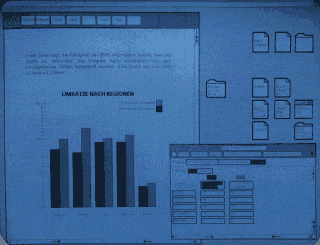 | 1981 June: Xerox introduces the Star, the commercial successor to the Alto. Notable features: Double-clickable icons, overlapping windows, dialog boxes and a 1024*768 monochrome display. |
| 1983 |
| 1984 |
| 1985 |
| 1986 |
| 1987 |
| 1988 |
| 1990 |
| 1992 |
| 1993 |
| 1994 |
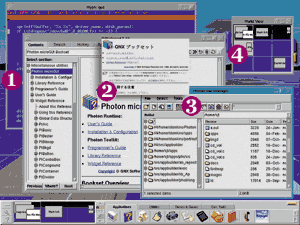 | 1994: QNX Software Systems releases the first embeddable microkernel windowing system, the Photon microGUI. |
| 1995 |
| 1996 |
| 1997 |
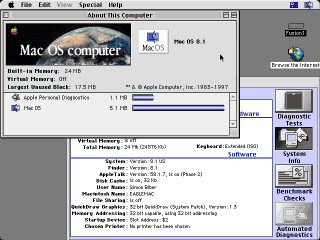 | July 1997: Mac OS 8 is finally released. Selling 1.25 million copies in less than 2 weeks, it becomes the best-selling software in that period. |
| 1998 |
| 1999 |
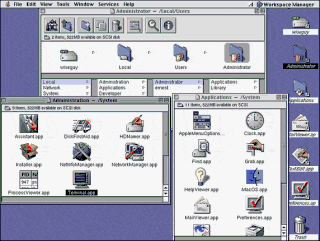 | March 1999 - Apple releases Mac OS X Server, a Unix based OS with their Macintosh GUI. |
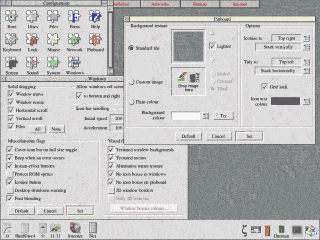 | June 1999 - RISCOS Ltd releases RISC OS 4 for RiscPC, A7000 or A7000+ machines. |
| 2000 |
| 2001 |
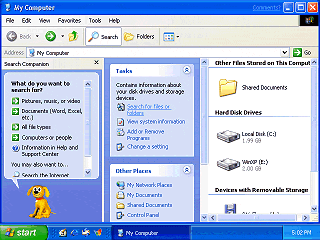 | October 25, 2001: Microsoft releases Windows XP (AKA Windows NT 5.1) Features: Tons of eye candy. "Product Activation" tethers XP to the existence of the Microsoft corporation. |
| 2003 |
 | April 24, 2003: Microsoft releases Windows Server 2003 (AKA Windows NT 5.2 and for a time called "Windows.NET server") Features: Drops the eye candy. Server-only release. |
I am limiting this timeline to systems that provide GUI services to other applications, this is why I am not including individual graphical DOS apps or older graphical programs such as
Sketchpad .
I am also not listing each version of a GUI system unless a significant change has occurred in it. MacOS has kept the same basic user interface since Version 1 and is therefore only mentioned a couple of times. Microsoft, on the other hand thinks it is fun
to make users learn a completely new interface every few years, so each of the Windows interfaces is listed. (Except for Windows ME which looked just like Windows 98 and 2000).
Issues:
X could just about have it’s own history page. There is no way I can list all of the different appearances of X here so I am just mentioning it’s creation. The picture is much more recent and not of the original X.
The picture of NextStep is of a later version.
The picture of PC-Geos is from Geos Ensemble 2.X with the presentation manager look.
The picture of BeOS is from a later version.
The color Mac screen shot is of MacOS 7.5.5, although these machines shipped with earlier versions.
I have insufficient information about the history of Tandy Deskmate and the Apollo workstation to place them on this timeline。
相关文章推荐
- 【python】图形用户界面入门:EasyGui学习超详细版
- /LGC设计模式/图形用户界面 (GUI) 的历史
- 计算机发展历史(详细)
- 微软MSN发展历史详细介绍(1995-2001)
- linux 的产生和发展(非常详细的历史)
- Lucene发展历史 最新版本Lucene 4.1
- 视窗操作系统的发展历史
- 搜索引擎发展的历史过程与发展现状 zhuan
- 1. 计算机语言的发展历史
- PC架构之CPU/RAM/IO总线的发展历史
- 黑马程序员—GUI图形用户界面
- 下载历史版本App超详细教程
- 《非零和时代》:人类历史发展与生物进化背后的基本的规律:环境恶劣,非零和的策略更容易生存 五星推荐
- GUI(图形用户界面)
- DotNET企业架构应用实践-企业管理软件架构(计算)的历史与发展(上) 推荐
- USB接口技术发展历史和接口技术的优点
- AI发展历史
- linux的历史发展与初步安装
- 《金融可以颠覆历史》:隐藏在历史事件背后的金融制度发展历程
- Web开发技术发展历史
